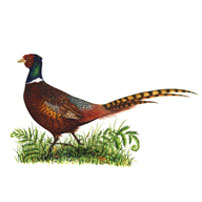Though dismissed by shooting’s opponents as an “alien”, the pheasant has adorned our countryside for at least a millennia. Like the rabbit and hare, it probably arrived with the Roman legions. Palladius, writing in the fourth century, advises on how to rear them and proof of its existence in Britain is provided in a Waltham Abbey Ordinance of 1059.
Also known as the longtail, it’s now our most familiar gamebird and the staple of driven shooting. It also provides testing sport. In 1905, 15 of the Edwardian great Shots were asked to name their most difficult bird. Ripon and Walsingham and a dozen others awarded the prize to the pheasant, especially the high curler dropping on motionless wings.
Today, the pheasant provides an even greater challenge. The shooting authority Sir Ralph Payne-Gallwey, in his High Pheasants in Theory and Practice</em> (published 1913), describes an “ordinary high pheasant as being 28 to 30 yards above the shooter”. Some Westcountry, Yorkshire and Welsh shoots now specialise in showing far higher birds yet many Guns can routinely fell 50-yard cloudscrapers with a combination of 32- and 34gm loads of No 5 or 4 shot. This takes skill and judgment; these same Guns do not address an out-of-range bird, which is rightly considered unsporting.
Restraint is also required in January. The aggressive treading of hens by the cocks, and the latter’s superfluity to successful breeding, has led to the tradition of “cocks only” days in January, especially on wild-bird shoots. On such days, it’s a crime to shoot hens, though some cannot resist the temptation. At the turn of the 20th century, it’s reputed that Sir Somerville Gurney succumbed, the hen plummeting to the ground in full sight of the Guns, who included King Edward VII. The King was said to remarked wryly “Ah, Gurney, you always were a great man for the ladies.”
A bag of pheasants, unlike grouse, is counted singly, though the keeper presents the Guns with a ‘”grace brace” at the end of the day. It’s good manners to accept it, not least because it reinforces the connection between shooting and food on the table, which is, after all, the essence of our sport.
